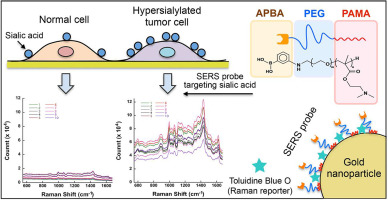当前位置:
X-MOL 学术
›
Biomaterials
›
论文详情
Our official English website, www.x-mol.net, welcomes your
feedback! (Note: you will need to create a separate account there.)
Application of surface enhanced Raman spectroscopy as a diagnostic system for hypersialylated metastatic cancers
Biomaterials ( IF 12.8 ) Pub Date : 2017-05-15 08:36:54 Babita Shashni, Yukichi Horiguchi, Kosuke Kurosu, Hitoshi Furusho, Yukio Nagasaki
Biomaterials ( IF 12.8 ) Pub Date : 2017-05-15 08:36:54 Babita Shashni, Yukichi Horiguchi, Kosuke Kurosu, Hitoshi Furusho, Yukio Nagasaki

|
Early diagnosis of metastatic cancers could greatly limit the number of cancer-associated deaths. Aberrant surface expression of sialic acid (hypersialylation) on tumors correlating with metastatic incidence and its involvement in tumorigenesis and progression is widely reported; hence detection of hypersialylated tumors may be an effective strategy to identify metastatic cancers. We herein report on the application of phenylboronic acid-installed PEGylated gold nanoparticles coupled with Toluidine blue O (T/BA-GNPs) as SERS probes to target surface sialic acid (N-acetylneuraminic acid, Neu5Ac). Strong SERS signals from metastatic cancer cell lines (breast cancer; MDA-MB231 and colon cancer; Colon-26) were observed, contrary to non-metastatic MCF-7 cells (breast cancer). The detected SERS signals from various cancer cell lines correlated with their reported metastatic potential, implying that our T/BA-GNP based SERS system was capable of distinguishing the metastaticity of cells based on the surface Neu5Ac density. T/BA-GNP based SERS system could also significantly differentiate between hypersialylated tumor tissues and healthy tissues with high SERS signal to noise ratio, due to plasmon coupling between the specifically aggregated functionalized GNPs. Furthermore, we also confirmed reduction in SERS signals from MDA-MB231 surface upon treatment with our original reactive oxygen species (ROS)-scavenging polymeric micelle, nitroxide-radical containing nanoparticles (RNPs). The ROS-mediated abrogation of sialylation by impairing the activation of NF-κB-sialyltransferase signaling cascade upon RNP treatment was confirmed by expression studies and the T/BA-GNPs based SERS system. The aforementioned findings thus, establish T/BA-GNPs based SERS as a potential cytodiagnostic system to detect hypersialylated metastatic tumors and RNPs as anti-metastatic cancer drug candidates.
中文翻译:

表面增强拉曼光谱作为高唾液酸化转移癌诊断系统的应用
转移性癌症的早期诊断可能会大大限制与癌症相关的死亡人数。广泛报道了唾液酸在肿瘤上的表面异常表达(hyperialylation),与转移发生率相关,并且参与了肿瘤的发生和发展。因此,高唾液酸化肿瘤的检测可能是鉴定转移性癌症的有效策略。我们在本文中报道了与甲苯磺酸蓝O(T / BA-GNPs)偶联的苯硼酸安装的聚乙二醇化金纳米颗粒作为SERS探针对目标表面唾液酸(N-乙酰神经氨酸,Neu5Ac)的应用。与非转移性MCF-7细胞(乳腺癌)相反,观察到来自转移性癌细胞系(乳腺癌; MDA-MB231和结肠癌; Colon-26)的强SERS信号。从各种癌细胞系中检测到的SERS信号与其报告的转移潜力相关,这表明我们基于T / BA-GNP的SERS系统能够根据表面Neu5Ac密度区分细胞的转移能力。基于T / BA-GNP的SERS系统还可以显着地区分高唾液酸化的肿瘤组织和具有高SERS信噪比的健康组织,这是由于特定聚集的功能化GNP之间存在等离激元耦合。此外,我们还证实,使用我们的原始活性氧物种(ROS)清除聚合物胶束,含氮氧化物自由基的纳米颗粒(RNP)处理后,MDA-MB231表面的SERS信号减少。通过表达研究和基于T / BA-GNPs的SERS系统证实了ROS介导的唾液酸化的消除,其通过损害RNP处理后NF-κB-唾液酸转移酶信号级联的激活而被破坏。因此,前述发现建立了基于T / BA-GNPs的SERS作为潜在的细胞诊断系统,以检测高唾液酸化的转移性肿瘤和RNPs作为抗转移性癌症药物的候选物。
更新日期:2017-05-16
中文翻译:

表面增强拉曼光谱作为高唾液酸化转移癌诊断系统的应用
转移性癌症的早期诊断可能会大大限制与癌症相关的死亡人数。广泛报道了唾液酸在肿瘤上的表面异常表达(hyperialylation),与转移发生率相关,并且参与了肿瘤的发生和发展。因此,高唾液酸化肿瘤的检测可能是鉴定转移性癌症的有效策略。我们在本文中报道了与甲苯磺酸蓝O(T / BA-GNPs)偶联的苯硼酸安装的聚乙二醇化金纳米颗粒作为SERS探针对目标表面唾液酸(N-乙酰神经氨酸,Neu5Ac)的应用。与非转移性MCF-7细胞(乳腺癌)相反,观察到来自转移性癌细胞系(乳腺癌; MDA-MB231和结肠癌; Colon-26)的强SERS信号。从各种癌细胞系中检测到的SERS信号与其报告的转移潜力相关,这表明我们基于T / BA-GNP的SERS系统能够根据表面Neu5Ac密度区分细胞的转移能力。基于T / BA-GNP的SERS系统还可以显着地区分高唾液酸化的肿瘤组织和具有高SERS信噪比的健康组织,这是由于特定聚集的功能化GNP之间存在等离激元耦合。此外,我们还证实,使用我们的原始活性氧物种(ROS)清除聚合物胶束,含氮氧化物自由基的纳米颗粒(RNP)处理后,MDA-MB231表面的SERS信号减少。通过表达研究和基于T / BA-GNPs的SERS系统证实了ROS介导的唾液酸化的消除,其通过损害RNP处理后NF-κB-唾液酸转移酶信号级联的激活而被破坏。因此,前述发现建立了基于T / BA-GNPs的SERS作为潜在的细胞诊断系统,以检测高唾液酸化的转移性肿瘤和RNPs作为抗转移性癌症药物的候选物。













































 京公网安备 11010802027423号
京公网安备 11010802027423号